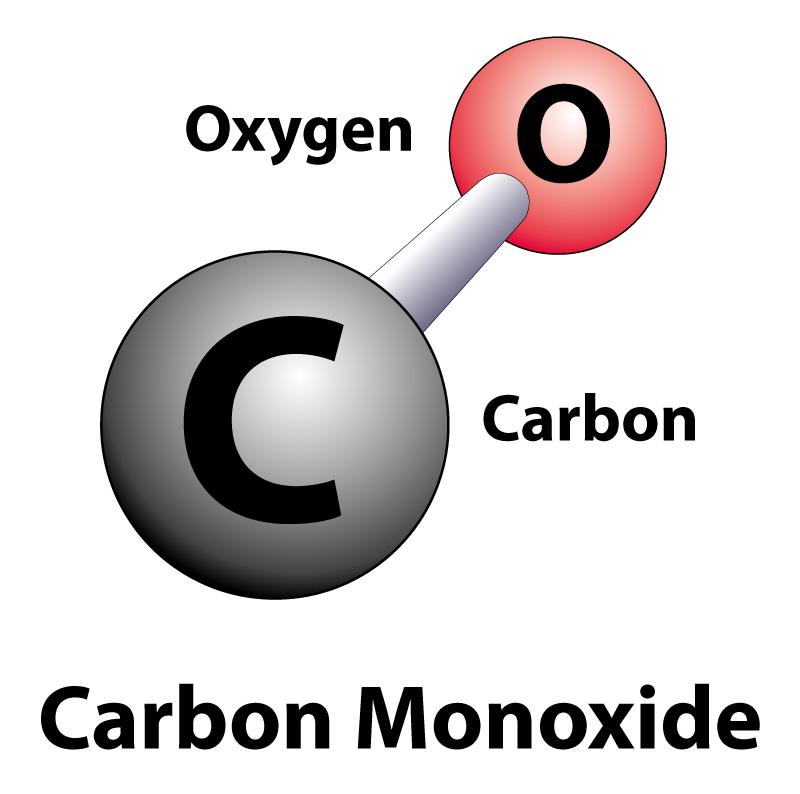Carbon monoxide (CO) is a poisonous, colourless, odourless, and tasteless gas. It is a common industrial hazard resulting from the incomplete burning of material containing carbon such as natural gas, gasoline, kerosene, oil, propane, coal, or wood.
CO can be produced by forges, blast furnaces and coke ovens, but the internal combustion engine is one of the most common sources of CO exposure.
Appliances that can cause carbon monoxide include:
- gas boilers
- gas cookers and clay ovens
- gas or paraffin heaters
- wood, gas and coal fires
- portable generators

Dangers of CO Poisoning
Carbon monoxide is harmful because as an odourless gas, it often mixes with other gases that do have a detectable odour. So, people can inhale carbon monoxide right along with gases that they smell and not even know that CO is present. When breathed, CO displaces oxygen in the blood and deprives the heart, brain, and other vital organs of oxygen.
During a fire, oxygen levels decrease, and the environment is likely to contain high levels of carbon monoxide and many other toxins.
Initial symptoms of carbon monoxide poisoning may include headache, fatigue, dizziness, drowsiness, nausea, and tightness across the chest.
Exposure to high levels of carbon monoxide can lead to vomiting, confusion, and collapse. It can even be fatal, causing you to lose consciousness and suffocate. But even if you recover, acute poisoning may result in permanent damage to the parts of your body that require a lot of oxygen such as the heart and brain. Significant reproductive risk is also linked to CO.
Who can be at risk?
People may be exposed to harmful levels of CO when working in boiler rooms, warehouses, petroleum refineries, pulp and paper production, steel production, around docks, blast furnaces, or coke ovens, or those working as:
- Welders
- Garage mechanics
- Firefighters
- Carbon-black makers
- Organic chemical synthesizers
- Metal oxide reducers
- Longshore workers
- Diesel engine operators
- Forklift operators
- Marine terminal workers
- Tollbooth or tunnel attendants
- Customs inspectors
- Police officers
How to prevent carbon monoxide poisoning
We provide a range of fixed and portable gas detection systems that can help protect your staff from the dangers of Carbon Monoxide, but there are many actions you can take to help reduce the risks of CO poisoning in the workplace:
- Install an effective ventilation system – especially in enclosed areas where gases of burning fuels may be released.
- Maintain equipment and appliances (e.g., water heaters, space heaters, cooking ranges) that can produce CO in good working order to promote their safe operation and reduce CO formation.
- Prohibit the use of gasoline-powered engines or tools in poorly ventilated areas.
- Report any situation to your employer that might cause CO to accumulate.
- Avoid the use of gas-powered engines, such as those in powered washers as well as heaters and forklifts, while working in enclosed spaces.
CO poisoning can be reversed if caught in time by
- Reporting promptly complaints of dizziness, drowsiness, or nausea.
- Avoiding overexertion if you suspect CO poisoning and leave the contaminated area.
For further information, help and advice please call our team at 02920 759 683 or contact us.
Sources: Occupational Safety and Health Administration (https://www.osha.gov/sites/default/files/publications/carbonmonoxide-factsheet.pdf)
Dräger Whitepaper “Understanding the Toxic Twins: HCN and CO” https://www.draeger.com/Products/Content/toxic-twins-wp-9103690-en-us.pdf
Author: Sabrina Toumi





